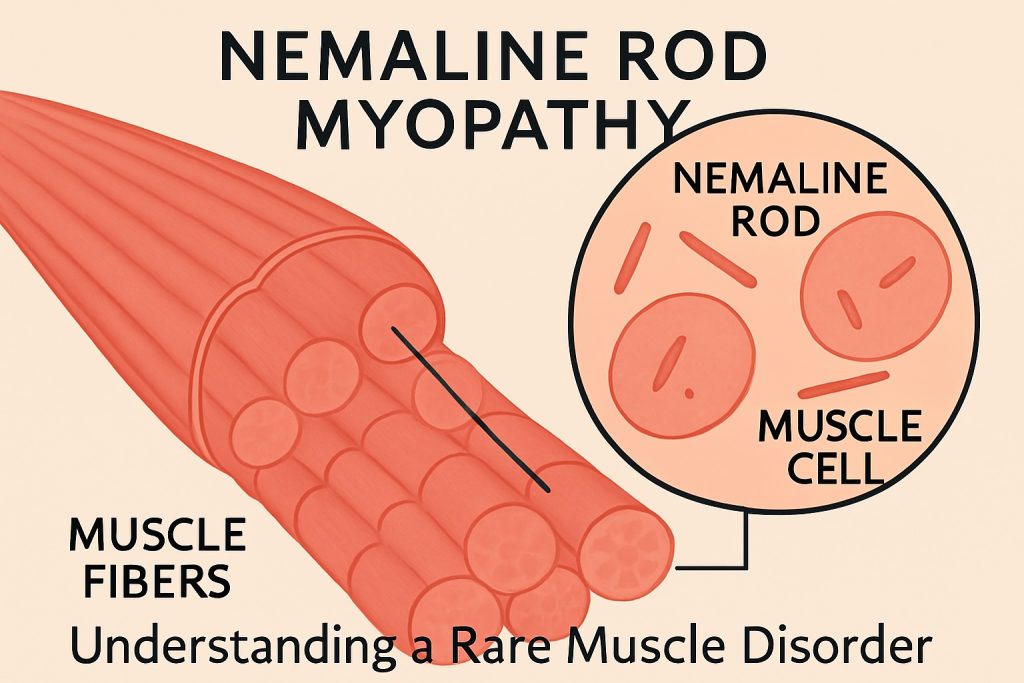
Nemaline rod myopathy, also called nemaline myopathy, is a rare but serious condition that mainly affects the skeletal muscles.It is characterized by the presence of nemaline bodies (rod-like inclusions) seen on muscle biopsy, and it can range in severity from mild to life-threatening. It can create major challenges for individuals and families across the United States. This overview explains the causes, symptoms, diagnosis, and current research on this unique disorder, providing helpful information for those looking for trustworthy details. In the United States, NRM is a recognized part of the broader spectrum of congenital myopathies, with an estimated prevalence of 1 in 50,000 live births.
What is Nemaline Rod Myopathy?
Nemaline rod myopathy is a genetic muscle disorder characterized by the presence of abnormal, thread-like structures (nemaline bodies) within muscle cells. The name comes from “nemaline,” meaning thread-like—referring to the rod-shaped structures seen in muscle cells under a microscope. Nemaline Rod Myopathy affects the way muscles contract, primarily due to genetic mutations affecting structural proteins in the muscle fiber. The disorder can appear at birth, during childhood, or, less commonly, in adulthood
Nemaline Rod Myopathy Symptoms
- Generalized muscle weakness, often most severe in the face, neck, upper limbs, and trunk
- low muscle tone (hypotonia)
- Delayed motor milestones in children
- Feeding and swallowing difficulties
- Respiratory issues due to weakened breathing muscles
- Abnormal spine curvature (scoliosis)
- Joint deformities (contractures)
- In rare late-onset forms, weakness may develop in adulthood
- Facial or skeletal abnormalities (e.g., high-arched palate, scoliosis)
Nemaline Rod Myopathy Diagnosis in the USA
The estimated incidence of nemaline rod myopathy is about 1 in 50,000 live births, making it the most common non-dystrophic myopathy in the United States. Both males and females are equally affected
Diagnosis typically involves:
- Detailed clinical examination of muscle strength and tone
- Genetic testing to identify causative mutations
- Muscle biopsy—microscopy reveals the characteristic nemaline rods
Nemaline Rod Myopathy Management and Treatment Options
Although there is no cure for NRM, a multidisciplinary approach is key to maintaining a good quality of life. Treatment plans usually include:
- Physical therapy and occupational therapy to maintain mobility and strength
- Respiratory therapy and use of devices to support breathing
- Nutritional support for those with swallowing problems
- Experimental options such as inspiratory muscle training and dietary L-tyrosine supplementation have shown limited promise in specific cases
- Participation in clinical trials, which continue to explore gene-targeted and supportive therapies
Access to coordinated care is improving in the U.S. thanks to the efforts and awareness raised by organizations such as:
- muscular dystrophy association (mda)
- National Organization for Rare Disorders (NORD)
- Cure CMD
Research and Future Outlook
The U.S. is a leader in rare disease research, and several institutions are actively studying Nemaline Myopathy. Research in the USA is focusing not only on supportive care but also on possible genetic and drug-based cures. Progress in gene therapy, muscle-boosting medications, and stem cell studies offers hope for future treatments.
- NIH Rare Diseases Clinical Research Network (RDCRN) is conducting natural history studies.
- Patient registries such as Cure CMD’s Congenital Myopathy Registry support data collection for future clinical trials.
- Gene therapy approaches are under preclinical development targeting NEB and ACTA1 mutations.
Pharmaceutical companies and research centers are exploring antisense oligonucleotides (ASOs), CRISPR-based editing, and protein-targeted therapies.
Living With Nemaline Rod Myopathy in the USA
The severity and progression of nemaline rod myopathy can vary a lot. Some people live active, fulfilling lives with only mild symptoms, while others face bigger challenges, including breathing problems that can be life-threatening in severe cases.
Conclusion
Nemaline Rod Myopathy is a severe, though uncommon, congenital myopathy that occurs in patients throughout the United States. Increasing awareness, improved genetic screening, and active clinical trials offer hope for better outcomes in the future. Prompt diagnosis and access to multidisciplinary care continue to be the most important factors in managing this condition


